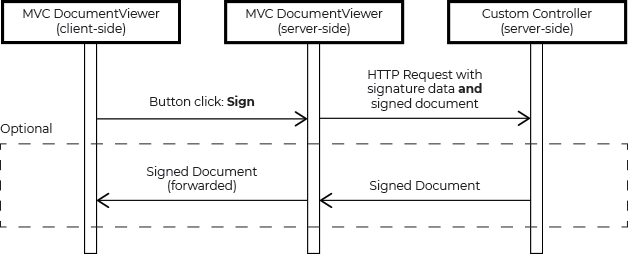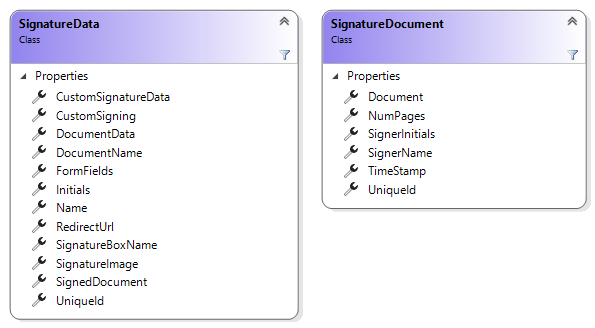Handling Signature Requests in ASP.NET Core
Since the custom signature handling is available, it is no longer required to route the signed document through client-side JavaScript. This article explains how to handle signature requests in a custom controller method.

Recently, we released a new version of the DocumentViewer that supports custom signature handling by routing the signature data and/or signed document to a given, custom endpoint in your ASP.NET web application.
Server-Side Processing
This is useful, if the signed document is stored server-side or needs to be further processed in your application. The sample project discussed in this article forwards the signed document and the associated data to a given URL. The following sequence diagram shows this workflow:

Sequence diagram: Sending signature data and signed document
Read more
Learn more about all supported workflows in this detailed article about the new functionality:
Define the Redirect URL
The following HTML helper code shows how to add the DocumentViewer to the view and to set the RedirectUrlAfterSignature to the custom Home/HandleSignature controller in the same application.
@Html.TXTextControl().DocumentViewer(settings => {
settings.DocumentPath = "App_Data/nda.tx";
settings.Dock = DocumentViewerSettings.DockStyle.Fill;
settings.SignatureSettings = new SignatureSettings() {
RedirectUrlAfterSignature = this.Url.Action(
"HandleSignature",
"Home",
new { securityToken = "1234" },
Context.Request.Scheme,
null),
ShowSignatureBar = true,
SignerName = "Tim Typer",
UniqueId = "1234-1234-1234-1234"
};
}).Render()Additionally, a query string parameter is given to show that additional, custom data can be forwarded to the request. In this sample, a simple securityToken string is forwarded to "validate" the request. In a real-world application, this could be any other data or a valid OAuth access token.
The custom controller HttpPost method HandleSignature is called by the DocumentViewer after a document has been signed successfully:
[HttpPost]
public IActionResult HandleSignature([FromBody] SignatureData data, string securityToken)
{
ReturnObject returnObject = new ReturnObject();
if (securityToken != "123")
{
return Ok(returnObject);
}
// here, you have access to the signed document and other meta data
var test = data.SignedDocument.Document;
returnObject.Success = true;
returnObject.Id = data.SignedDocument.UniqueId;
return Ok(returnObject);
}
public class ReturnObject
{
public string Id { get; set; }
public bool Success { get; set; } = false;
}The forwarded SignatureData object contains meta data about the signature and the signed document:

The securityToken is checked for "validity". If valid, a return object is created with information that should be passed back to client-side JavaScript. This is not required, but useful to provide a feedback to users. Implicitly, to be flexible, the DocumentViewer will always return a string and your custom endpoint should return a 200 status code in all cases - even if your custom method is failing. From the signing perspective, the action is fulfilled and successful. Therefore, in this demo, a ReturnObject is returned with a Success property.
Client-Side Callback
On client-side, the setSubmitCallback method is used to attach a method that is called after a successful roundtrip to your custom controller method:
// attach the callback
window.addEventListener("documentViewerLoaded", function () {
TXDocumentViewer.signatures.setSubmitCallback(handleSignedDocument);
});
function handleSignedDocument(data) {
var returnObject = JSON.parse(data);
if (returnObject.success === true)
alert("Thanks for signing!");
else
alert("Signing failed!");
}As the return value is always a string, it can be parsed into an object and directly accessed.
Test this on your own and download the sample application from our GitHub account.
![]()
Download and Fork This Sample on GitHub
We proudly host our sample code on github.com/TextControl.
Please fork and contribute.
Requirements for this sample
- TX Text Control .NET Server 30.0
- Visual Studio 2022
ASP.NET
Integrate document processing into your applications to create documents such as PDFs and MS Word documents, including client-side document editing, viewing, and electronic signatures.
- Angular
- Blazor
- React
- JavaScript
- ASP.NET MVC, ASP.NET Core, and WebForms
Related Posts
E-Sign Comes to Blazor: Document Viewer 33.0.1 Released
We are excited to announce the release of TX Text Control Document Viewer 33.0.1 for Blazor! This version comes packed with one of the most requested features: Electronic signature support.
Adoption of Electronic vs. Paper Signatures in 2025
The move to electronic signatures has accelerated in recent years. However, many organizations still rely on paper signatures for core processes. This article examines the current state of…
Sign Documents with a Self-Signed Digital ID From Adobe Acrobat Reader in…
This article shows how to create a self-signed digital ID using Adobe Acrobat Reader and how to use it to sign documents in .NET C#. The article also shows how to create a PDF document with a…
ASP.NETASP.NET CoreCertificate
How to Sign Signature Fields with Custom Signer Information and Time Stamps…
This article shows how to sign signature fields in a PDF document with custom signer information and timestamps using the TX Text Control .NET Server component in ASP.NET Core C#. The signature is…
ASP.NETASP.NET CoreDocument Viewer
Transforming Financial Documents into Smart and Secure Forms in ASP.NET Core C#
This article shows how to transform financial documents into smart and secure forms in ASP.NET Core C#. All the necessary steps, from prepopulating the form fields to digital signatures, are…






